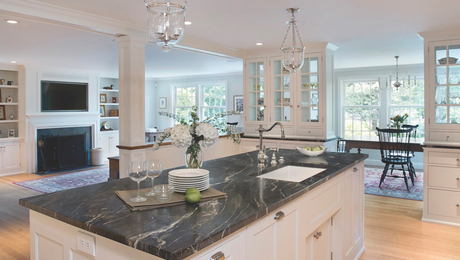A House Transformed
Using seven key remodeling principles, architect Pi Smith turns a family keepsake into her new home.

Synopsis: This story illustrates seven essential concepts that should not be overlooked when remodeling a home. See how architect Pi Smith used these key remodeling principles to renovate a 19th-century Vermont farmhouse into a home for the way she lives today, while preserving the house’s original character. The article is adapted from Matthew Schoenherr’s House Transformed: Getting the Home You Want with the House You Have (Taunton, 2005).
Many of us live in houses we’re not really happy with. The rooms may be too small, the ceilings too low; our home may lack character, or simply be worn out and in need of repair. We might be told the solution is as easy as replacing the siding or adding a window—or as complex and costly as tearing the house down and rebuilding the whole thing.
Can a house shed its coat and emerge as something new? Can something as large as a house be transformed? As stout and permanent as they seem, houses are malleable and capable of stretching and growing, just as people do.
Because no two houses are the same, there’s no absolute blueprint out there to tell you exactly how your home should be modified. But there are some basic design guidelines that can help everyone.
As an architect, whenever I embark on any new design project, I refer to my own checklist of seven essential items that should never be overlooked when transforming a home. I call them the “Seven Knows” because each involves acknowledging something about your house as it is—and as you want it to be.
Fellow architect Pi Smith used these seven essentials to transform her family’s 19th-century keepsake into an exuberant contemporary home. The Vermont farmhouse she shares with her daughter, Zia, and partner, Ann Bumpus, was at one time a beloved family retreat. But it was woefully ill suited to full-time living, particularly to a casual lifestyle that includes frequent entertaining and a busy toddler. “The house had been adapted in a piecemeal way over the years,” Smith says. “There was a poor flow for entertaining, and we were really limited by the existing layout.” Smith knew that creating her perfect home would take more than another round of piecemeal fixes. It would mean transforming the structure into something altogether new, something closer to her ideal. Here’s how she did it.
1. Know your place
Acknowledge your region, town, or city
Though Smith wanted to change the interior character of her house, she wanted the outside to retain the classic charm she had cherished as a child. “This was an emotionally important house in the history of my family,” she says. “I didn’t want to do something that was going to transform the outside in a way that took away those memories.” So all the exterior changes were restricted to the rear of the house, where several new windows and skylights were added to open the house up without changing its stoic New England façade. On the public side, Smith stayed with divided-light windows and also retained the rolling barn door, even though the opening behind it was eliminated. And although the interior is a riot of warm, inviting colors, Smith chose to leave the exterior its puritan white.
For more photos and more information on the seven essential items that should never be overlooked when transforming a home, click the View PDF button below.

























